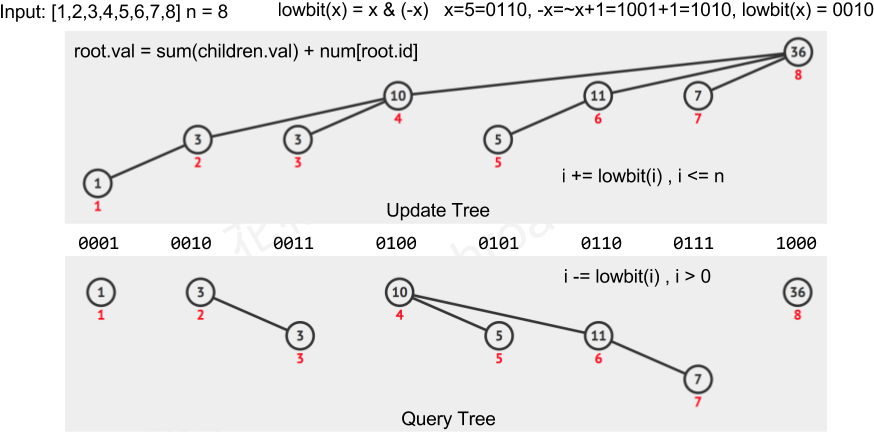LeetCode307 - (medium) Range Sum Query - Mutable
文章目录
Task
Given an integer array nums, find the sum of the elements between indices i and j (i ≤ j), inclusive.
The update(i, val) function modifies nums by updating the element at index i to val.
Example
|
|
Note:
- The array is only modifiable by the update function.
- You may assume the number of calls to update and sumRange function is distributed evenly.
BIT
- 对于prefix sum问题,使用
BIT(Binary Indexed Tree,又叫Fenwick Tree,又叫树状数组)可实现O(log(n))时间内求解数组的prefix sum,并在数组中一个值发生变化时以O(log(n))的时间更新节点值
motivation
- 假设要求数组x=[2,5,-1,3,6]的第i项到第j项和,可求数组的累计和得到s=[2,7,6,9,15],用s[j]-s[i-1]即可
- 但当数组中某个值发生变化时,必须重新求累计和,时间是O(n)
- BIT的设计初衷是维护一个数据结构,使得:
- 数组中某个数值发生变化时,可在O(log(n))时间内更新该数据结构
- 需要数组前k项和时,可在该数据结构上以O(log(n))的时间求出结果
- 维护一个树状结构,深度是O(log(n)):
- 数值发生变化(
update)时,从该位置对应节点向根部遍历,时间是O(log(n)) - 求前k项和(
query)时,从该位置对应节点向根部遍历,时间是O(log(n))
- 数值发生变化(
树状结构
- 举个例子:对于数组[1,2,3,4,5,6,7,8]
- update和query对应的数据结构不一样,如下图:

- 维护
update tree:- 对于数组中的位置
x(红色数字,索引从1开始),每个位置的父节点是位置为x+lowbit(x)的节点。根节点必是数组中最后一个位置 - lowbit(x)是将x转换为二进制后,最低位的1及其后面的部分,快速计算方法:
lowbit(x)=x&(-x),其中负数使用补码,即-x=~x+1 - 数组某个位置的值增加k时,将该位置对应节点向上直到根节点这条路径上的所有节点值都增加k(初始化时要做n次这样的操作)
- 对于数组中的位置
- 维护
query tree:- 对于数组中的位置
x(红色数字,索引从1开始),每个位置的父节点是位置为x-lowbit(x)的节点。根节点必是2的幂(因为减到最后,二进制形式中只剩下一个1) - 需要求前k项和时,将k对应节点向上直到根节点这条路径上的所有节点相加即是所求值
- 对于数组中的位置
时间复杂度:由于每次update/query时都是从叶子节点向根节点遍历,而数深度是O(log(n)),故update/query的时间复杂度都是O(log(n))空间复杂度:由于BIT本质上是比原数组多一个0索引的数组,故空间复杂度是O(n)
实现
|
|
Solution
- 直接使用上面的FenwickTree类
时间复杂度:初始化时要对n个数值都update BIT,故时间复杂度是O(nlog(n))空间复杂度:每次修改一个值只需update一次,时间复杂度是O(log(n))- 实现:
|
|